|
All Boardwalk games apply the same basic
set of rules. At first, these may seem foreign, but
once they are understood, all variations of "Hopscotch" will be made
available. This should take four minutes to learn.
With another few minutes of learning, one should
know how to use a "hand", where the player gains
power and a larger world of
variations will be made available. Further elements
will be
easy to pick up, making additional variations available. Some
of these elements can be found in the software's documentation on
creating new games.
You may also create and play your own variations using these elements.
|
Boardwalk Basics
-
The Boardwalk Deck
-
Stacking by Rank
-
Columns
-
The Walks (upper, lower)
-
Standard Plays
-
Rule of Ascending Order
-
Slide Plays
-
"Hopscotch":
off you go!
|
Advanced
|
The Boardwalk Deck
All variations of Boardwalk draw their cards from
the total Boardwalk deck. This deck includes five-of-a-kind of
each of twenty one ranks. The fifth suit is called "oceans"
(which tends to be used on very large game boards). Three of
these ranks are wild types: Wilds, Frees, and Jokers. While
these types are free of rules of ascending order, they will still
have to be accumulated by rank wherever they are used. For
further details on this, please see the "Ranks" section in the
software documentation for creating new
games.

Unless otherwise stated, for all of the instructions
contained herein, we will be using a standard 52-card deck.
Stacking By Rank
|
Boardwalk is derived from the traditional game of
"Clock Solitaire". What is
unique to this type of game is that the cards are never stacked
on foundations by sequence or suit. Like
Clock, cards in Boardwalk may only be stacked on foundations by face
value, or "rank". Aces may be stacked on one foundation, Deuces on
one other, and so forth.
|
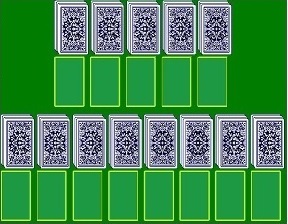 |
Columns
|
The Boardwalk board is comprised of "columns".
Each column includes one
tableau over one foundation, vertically arranged. At the
beginning of the game, there are four cards dealt face-down on each
tableau. At the end of a perfectly scored game, each tableau
will be empty, and each foundation will have accumulated
four-of-kind.
|
A Column

|
The Walks
Boardwalk always includes two sets of columns; one
upper and one lower. Upper and lower columns operate in
distinctly different ways.
The Upperwalk
|
The upper, or "lead walk" is the set of columns dealt across the
top of the board. Here, the top card of each tableau
pile is
always flipped up and available for play.
On the upperwalk, a given column's
foundation cannot be stacked upon until its tableau has been
emptied. Once a column's tableau is emptied, its respective foundation
becomes available for freely stacking your choice of one
rank upon it. As such, at the beginning
of the game, all upperwalk foundations are blocked from play.
Stacking a card on an upper foundation is called
"filing". An upper column's last tableau card may be
filed upon its own foundation, since the block on the foundation is
removed in the act of initiating the play.
|
Upper Column
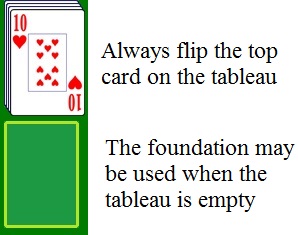 |
The Lowerwalk
|
The lower, or "live walk" is the set of columns dealt across the
board directly beneath the upperwalk. At the beginning of the
game, all lowerwalk foundations may be stacked upon. This is
done by placing a card upon a column's foundation, as inseparably
followed by flipping up, in place, the top card of its corresponding tableau
pile. When the last of a kind is placed on a column's foundation, the last card of its corresponding tableau pile
will flip up (and be made available for play).
There cannot be two face-up cards on top of
any one tableau pile at a time. If there is a face-up card on top of
a column's tableau, then its corresponding foundation is "blocked". The face-up card
on the tableau pile must be moved, i.e. played elsewhere,
before its respective foundation may be stacked upon again.
Stacking a card on a lower foundation and flipping
on the tableau above it is called a
"live play". A lower column's blocking card may be
played live to its own foundation, since the block on the foundation
is removed in the act of initiating the play.
|
Lower Column
 |
Standard Plays
|
Face-up cards atop (row 1 and 3) tableaus may be
stacked upon available (row 2 and 4) foundations.
The player chooses which rank they will accumulate
upon each foundation. These selections are called
"declarations". Once one card has been stacked on a
foundation, only cards of the same rank may be stacked on top of it,
and not upon any other foundation.
Each card placed on a foundation can no longer be moved,
and will score one point at the end of the game. When row 1 is
cleared, the player scores a "win", and when all tableaus are
cleared, the player scores a "perfect game".
|
An Example of 52 Cards on the Deal
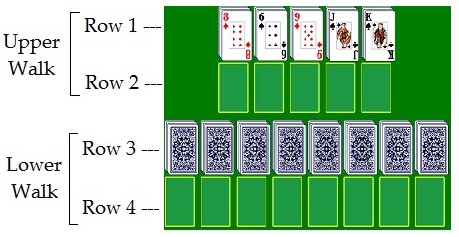 |
Rule of Ascending Order
|
Aces are always the lowest rank in the deck.
For a given Boardwalk variation, one may be required to never stack
a higher rank to the left of a lower one, or a lower rank to the
right of a higher one, on a given walk. One should
generally expect this to be the case on the lowerwalk. In a
percentage of Boardwalk variations, an ascending order rule may also
apply across the upperwalk.
|
Ascending Declarations
 |
The "Slide Play"
| On row 3 where the lower tableaus reside, when a stack
location has no cards upon it, the player has the option of "sliding" one face-up card
from any row 1 or 3 pile to that spot. The card
moved will still be available, as source, for further play. In
effect, any one blocking card on the board may be moved to that
opening. |
 |
Hopscotch: Off You Go!
|
Hopscotch is the root class of Boardwalk variations,
and from what you have seen thus far, you are ready to give this
game a go. All variations of Hopscotch apply the ascending order rule on the
lowerwalk only.
There are
various ways to deal Hopscotch. The recommended introductory
variation is "Hop 45", a.k.a. "Boardwalk Tic-Tac-Toe".
This game has three cards each of nine ranks - from Ace to 9, for a
total of twenty-seven cards. Each of nine tableau piles begin
with three cards, and at the end of a perfect game, this board will be arranged as
three-of-a-kind on each of nine foundations. |
Hop 45 on the Deal
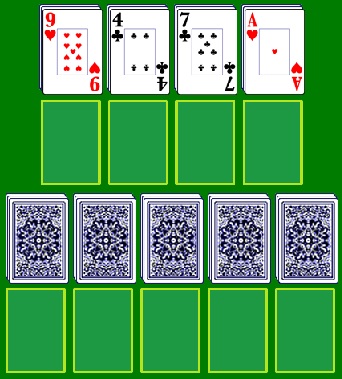
|
Playing With a Hand
The "hand" greatly expands a player's power in
Boardwalk.
We will effectively remove one column from the board, and take
its tableau cards as the starting hand. These cards will be
dealt in a row below the lowerwalk, or if using a
physical deck of cards, then you can just hold them in your hand.
The hand is also sometimes called "row 5".
When making a play using the hand, one hand card
will be placed upon the board, and one card from the board will
be moved, or "returned" to the hand. At the end of the game, the hand score is a card count of its
most frequently occurring rank, making four-of-a-kind a perfect
hand score.
|
52 Cards on the Deal
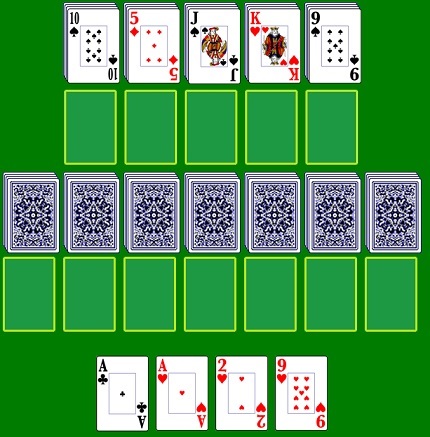 |
52 Cards Perfectly Scored
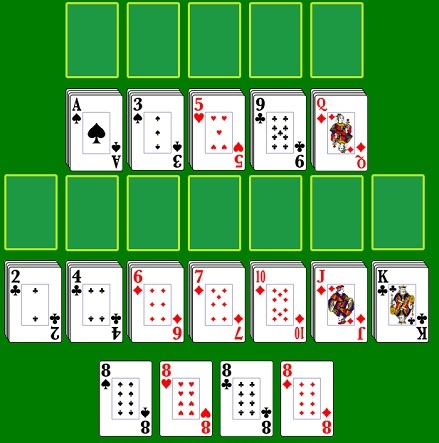 |
Playing the Lowerwalk From the Hand
A card from the hand is placed on a lowerwalk
foundation, and a card
from a lowerwalk tableau is returned to the hand. After the return card to the
hand has been selected, as in any live play, one must flip up the
top card of the tableau above the foundation played.
When the column played is blocked, the blocking card must be
returned to the hand, and the next card on the column's tableau flipped up, in place.
When the column played is not blocked, any other
blocking card from row 3 may be returned to the hand. This is known
as a "power play".
There is also the "blind play" to an unblocked column, where the
player chooses to return to the hand the card that will flip on row
3 before seeing what it is.
| As depicted at right, the Four and the Jack in the hand
may be played live on the lowerwalk. Where the Four is played,
it is stacked on the Fours foundation. Since that
foundation is blocked (by a Five), that Five must be returned
to the hand, so that the next card underneath it can (and
will) be flipped up.
Where the Jack may be stacked (far right), it is
not blocked. One may return any one of the four
face-up tableau cards to the hand, followed by flipping up
the next card above the Jacks. As a blind play, one
may also choose to return the tableau card that is to flip
above the Jacks to the hand before seeing what it is.
|
Lowerwalk and Hand
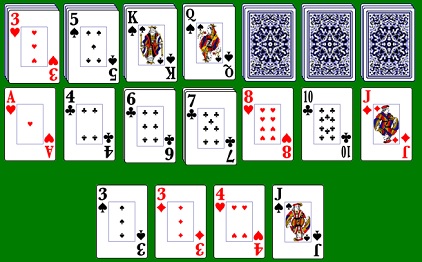 |
You now know how to play the Boardwalk variations
known as "Lucky ...". These games get their name
because hand cards may only play live upon the lowerwalk, so if
any card in the hand cannot play there, it will have to stay in the
hand for the rest of the game. In these variations, the
ascending order rule applies only to the lowerwalk.
Playing the Upperwalk From the Hand
Boardwalk variations known as "Scotsi ..." allow playing both walks from the hand, and due to the power
granted to the player, they are accompanied by the additional requirement
that each of the two walks must be declared in ascending order.
Having to coordinate two ascending order walks in
tandem may seem cerebrally intense at first, but this sense of the
game should tone down after playing it a couple of times.
|
A card from the hand may be (legally) stacked upon a row
2 position. This is a "trump play". Where an
upperwalk column is completely void of cards (on both rows 1
and 2), a card from the hand may be placed upon that
column's row 1 position. This is know as a "high trump
play", and also as "juggling".
A hand card filed on a row 2 position scores one point
and is done moving for the rest of the game. A hand
card placed upon a row 1 position will still be available as
source for further play. At right: The Threes in the hand
can be stacked in the open upperwalk "slot". To start,
place one of them upon the row 1 or 2 position as desired,
and return your choice of face-up row 1 card to the hand. |
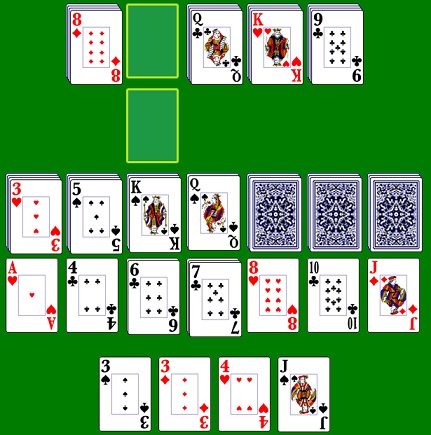 |
| At right: Continuing the game above, a Three from the
hand has been filed in the opening. In this example,
the Queen from atop the third upper tableau was returned to
the hand, followed by a Two flipping up next on the upper
tableau.
At this point, the row 1 spot is no longer available for
play. The next Three in the hand can be filed on top
of the former, and the player's choice of row 1 cards can be
returned to the hand. |
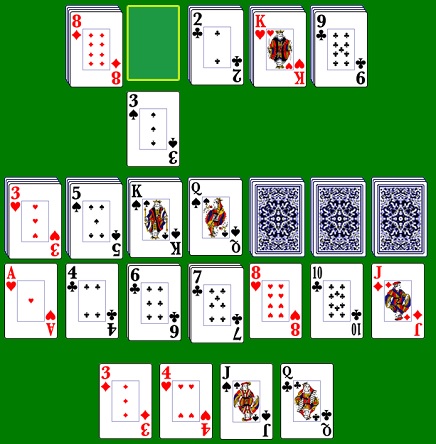 |
The Perpetual Play Rule: Since it is possible to
play high trump without having caused any other card on the board to
flip, it may be possible to do so back-and-forth
without end. And so, where a high trump play does not induce a flip,
the card played to row 1 cannot from that time forward be gathered
back into the hand until at least one other card anywhere on the
board has flipped.
Coaxing and Favors
When we introduce "coaxing" and "favors", there will
be one small retraction from standard Boardwalk rules. On the
upper tableaus, we will not automatically flip up the top cards.
What will happen here is that the act of flipping up a card atop an
upper tableau will be called "taking a favor".
Below: Standard 52-Card Cheshire takes two favors on
the deal, and requires the player to take one more favor as the
first play of the game.
|
52-Card Cheshire on the Deal
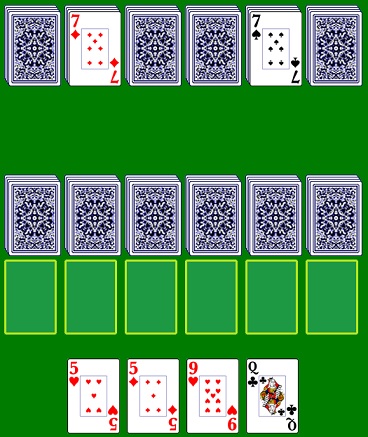 |
... And with one "favor" taken
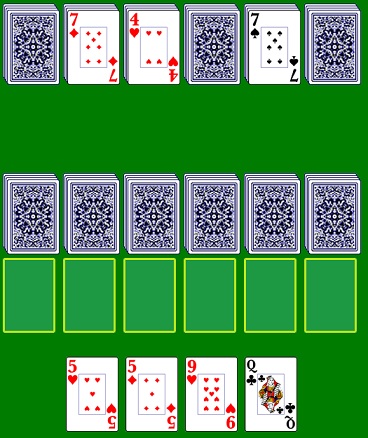 |
"Coaxing" is a type of hand play. Unlike high
trump, coaxing is where a row 1 stack has no face-up card on it, but
does have face-down cards. In this case, the player can stack
a card from the hand to the top of that stack, returning one face-up
card from row 1 to the hand.
The Perpetual Play Rule applies to coaxing just as
it does to high trump plays.
You now know how to play Cheshire.
|















